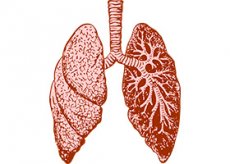Medical expert of the article
New publications
Lung tissue grown in vitro is ready for transplantation
Last reviewed: 02.07.2025

All iLive content is medically reviewed or fact checked to ensure as much factual accuracy as possible.
We have strict sourcing guidelines and only link to reputable media sites, academic research institutions and, whenever possible, medically peer reviewed studies. Note that the numbers in parentheses ([1], [2], etc.) are clickable links to these studies.
If you feel that any of our content is inaccurate, out-of-date, or otherwise questionable, please select it and press Ctrl + Enter.

Growing various tissues and organs "on order" is a long-standing dream of many doctors and patients. Therefore, the world's first case of transplantation of lung tissue grown in a test tube became a landmark for all transplantologists.
This summer, scientists from the University of Texas (Galveston) successfully transplanted artificially grown lungs into animals.
Lung tissue was obtained using cutting-edge biotechnological methods. As a result, a full-fledged circulatory system was formed, and the survival rate of the operated patients increased.
Of course, the method requires many more years of observation and possible refinement so that the "new" lungs can perform their function for many years after transplantation. However, it is already clear that "test tube" tissues will help eliminate the shortage of donor transplants: this problem is currently more relevant than ever before.
Renowned American transplant surgeon Brian Whitson, representing the Wexner Medical Center (Ohio), has already described the scientists' work as a "monumental achievement" in the field of organ transplants.
How exactly does lung tissue grow in the laboratory? First, scientists “stripp” the lungs of blood and cellular structures using a special mass consisting of sugars and surfactants. As a result, a kind of “skeleton” remains, which is a framework with a protein structure. Then this framework is filled: nutrients, growth factors and the “receiving” organism’s own cells are used.
Finally, the cells colonize a completely new organ, ready for transplantation.
The full cycle of the procedure – from the moment of “getting rid” to the surgical transplant – lasts one month.
The specialists euthanized several animals at different times after the operation. The study only confirmed that the transplanted lungs form a fully functional vascular network inside themselves and are colonized by natural flora.
Not a single problem with respiratory function was noted in the operated animals. No rejection processes were recorded. This is especially important considering that the animals did not receive immunosuppressive drugs, as is usually the case after such operations. "It is impossible not to point out such an advantage. After all, most side effects during the rehabilitation period are caused by the use of immunosuppressants," explains Professor Whitson.
It turns out that in the near future surgeons will be able to transplant a genetically equal, practically "native" organ grown in a few weeks. Moreover, such material can be "ordered" in the required volume, without a long wait and unnecessary risk.
Experts have already estimated the approximate cost of the new organ – about 12 thousand US dollars. For comparison, today the minimum price of a lung transplant in the United States is estimated at 90-100 thousand dollars.
At the moment, in American clinics alone, more than one and a half thousand patients are waiting for their turn for a lung transplant. Doctors note with bitterness: not all of them will live to see their donor organ. Therefore, the use of new technologies is a truly important step in the right medical direction.
The information is presented on the pages of the publication Science Translational Medicine.


 [
[